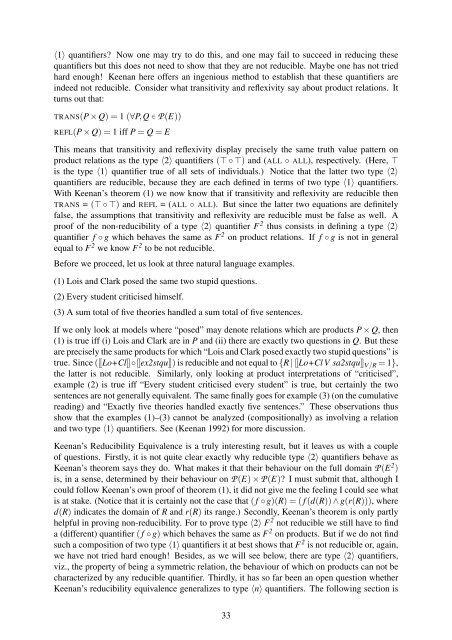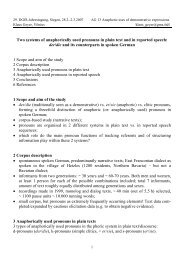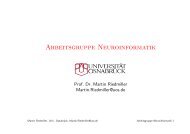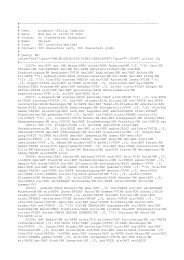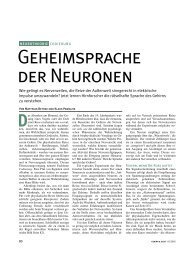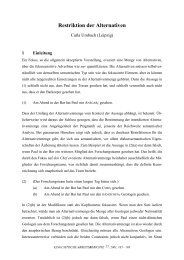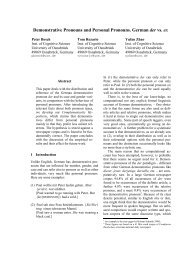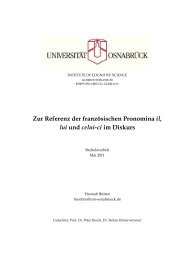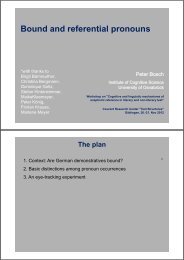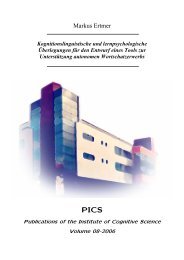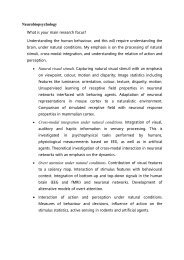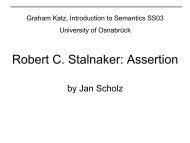Proceedings of the 6th Annual Meeting of the - Heinrich-Heine ...
Proceedings of the 6th Annual Meeting of the - Heinrich-Heine ...
Proceedings of the 6th Annual Meeting of the - Heinrich-Heine ...
Create successful ePaper yourself
Turn your PDF publications into a flip-book with our unique Google optimized e-Paper software.
〈1〉 quantifiers? Now one may try to do this, and one may fail to succeed in reducing <strong>the</strong>se<br />
quantifiers but this does not need to show that <strong>the</strong>y are not reducible. Maybe one has not tried<br />
hard enough! Keenan here <strong>of</strong>fers an ingenious method to establish that <strong>the</strong>se quantifiers are<br />
indeed not reducible. Consider what transitivity and reflexivity say about product relations. It<br />
turns out that:<br />
TRANS(P × Q)=1 (∀P,Q ∈ P (E))<br />
REFL(P × Q)=1iffP = Q = E<br />
This means that transitivity and reflexivity display precisely <strong>the</strong> same truth value pattern on<br />
product relations as <strong>the</strong> type 〈2〉 quantifiers (⊤◦⊤) and (ALL ◦ ALL), respectively. (Here, ⊤<br />
is <strong>the</strong> type 〈1〉 quantifier true <strong>of</strong> all sets <strong>of</strong> individuals.) Notice that <strong>the</strong> latter two type 〈2〉<br />
quantifiers are reducible, because <strong>the</strong>y are each defined in terms <strong>of</strong> two type 〈1〉 quantifiers.<br />
With Keenan’s <strong>the</strong>orem (1) we now know that if transitivity and reflexivity are reducible <strong>the</strong>n<br />
TRANS = (⊤◦⊤) and REFL =(ALL ◦ ALL). But since <strong>the</strong> latter two equations are definitely<br />
false, <strong>the</strong> assumptions that transitivity and reflexivity are reducible must be false as well. A<br />
pro<strong>of</strong> <strong>of</strong> <strong>the</strong> non-reducibility <strong>of</strong> a type 〈2〉 quantifier F2 thus consists in defining a type 〈2〉<br />
quantifier f ◦ g which behaves <strong>the</strong> same as F2 on product relations. If f ◦ g is not in general<br />
equal to F2 we know F2 to be not reducible.<br />
Before we proceed, let us look at three natural language examples.<br />
(1) Lois and Clark posed <strong>the</strong> same two stupid questions.<br />
(2) Every student criticised himself.<br />
(3) A sum total <strong>of</strong> five <strong>the</strong>ories handled a sum total <strong>of</strong> five sentences.<br />
If we only look at models where “posed” may denote relations which are products P × Q, <strong>the</strong>n<br />
(1) is true iff (i) Lois and Clark are in P and (ii) <strong>the</strong>re are exactly two questions in Q. But <strong>the</strong>se<br />
are precisely <strong>the</strong> same products for which “Lois and Clark posed exactly two stupid questions” is<br />
true. Since ([[Lo+Cl]] ◦[[ex2stqu]]) is reducible and not equal to {R | [[Lo+Cl V sa2stqu]] V/R = 1},<br />
<strong>the</strong> latter is not reducible. Similarly, only looking at product interpretations <strong>of</strong> “criticised”,<br />
example (2) is true iff “Every student criticised every student” is true, but certainly <strong>the</strong> two<br />
sentences are not generally equivalent. The same finally goes for example (3) (on <strong>the</strong> cumulative<br />
reading) and “Exactly five <strong>the</strong>ories handled exactly five sentences.” These observations thus<br />
show that <strong>the</strong> examples (1)–(3) cannot be analyzed (compositionally) as involving a relation<br />
and two type 〈1〉 quantifiers. See (Keenan 1992) for more discussion.<br />
Keenan’s Reducibility Equivalence is a truly interesting result, but it leaves us with a couple<br />
<strong>of</strong> questions. Firstly, it is not quite clear exactly why reducible type 〈2〉 quantifiers behave as<br />
Keenan’s <strong>the</strong>orem says <strong>the</strong>y do. What makes it that <strong>the</strong>ir behaviour on <strong>the</strong> full domain P (E 2 )<br />
is, in a sense, determined by <strong>the</strong>ir behaviour on P (E) × P (E)? I must submit that, although I<br />
could follow Keenan’s own pro<strong>of</strong> <strong>of</strong> <strong>the</strong>orem (1), it did not give me <strong>the</strong> feeling I could see what<br />
is at stake. (Notice that it is certainly not <strong>the</strong> case that ( f ◦ g)(R)=(f (d(R)) ∧ g(r(R))), where<br />
d(R) indicates <strong>the</strong> domain <strong>of</strong> R and r(R) its range.) Secondly, Keenan’s <strong>the</strong>orem is only partly<br />
helpful in proving non-reducibility. For to prove type 〈2〉 F 2 not reducible we still have to find<br />
a (different) quantifier ( f ◦ g) which behaves <strong>the</strong> same as F 2 on products. But if we do not find<br />
such a composition <strong>of</strong> two type 〈1〉 quantifiers it at best shows that F 2 is not reducible or, again,<br />
we have not tried hard enough! Besides, as we will see below, <strong>the</strong>re are type 〈2〉 quantifiers,<br />
viz., <strong>the</strong> property <strong>of</strong> being a symmetric relation, <strong>the</strong> behaviour <strong>of</strong> which on products can not be<br />
characterized by any reducible quantifier. Thirdly, it has so far been an open question whe<strong>the</strong>r<br />
Keenan’s reducibility equivalence generalizes to type 〈n〉 quantifiers. The following section is<br />
33


